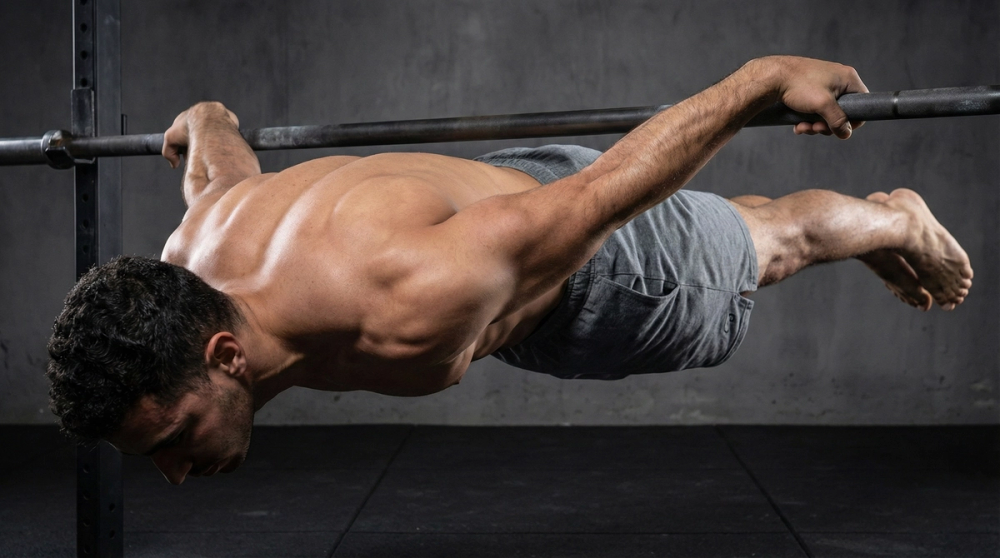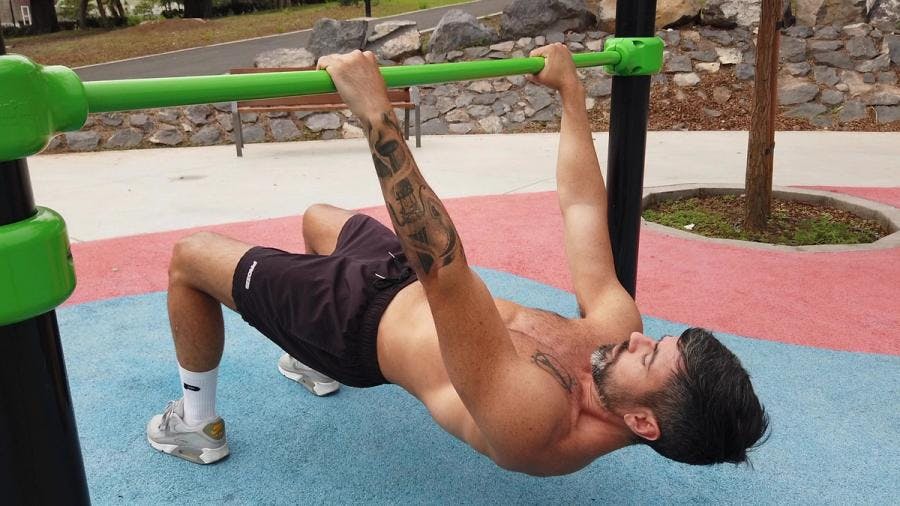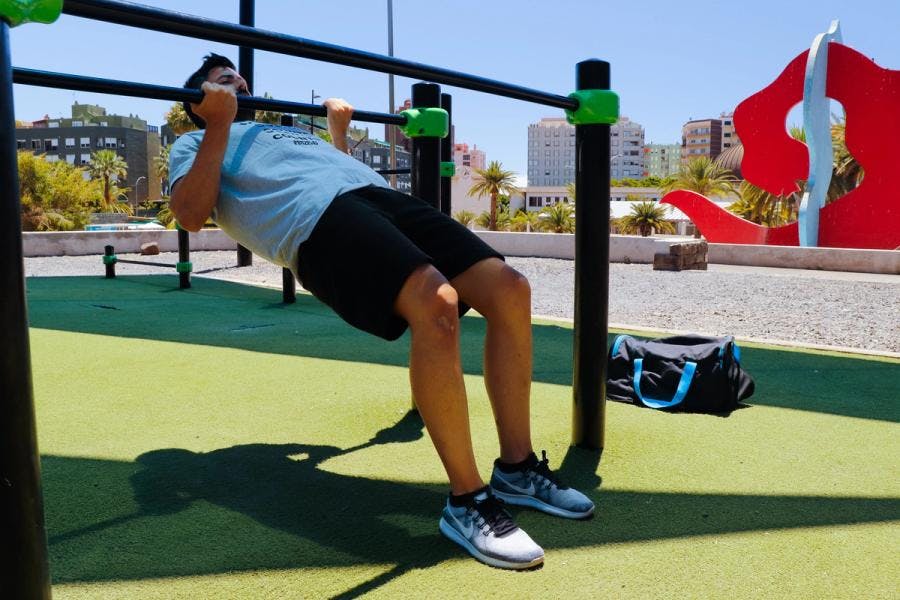Pull-ups are one of the fundamental calisthenics exercises and a favorite for anyone who wants to build strength or muscle mass in the back (lats and upper back), arms (biceps and forearms), and the pulling pattern in general.
They are so effective because in this exercise our body weight usually represents such a high intensity that, with just a few reps, we are already pushing the involved muscles close to their maximum effort.
If we compare them, for example, with a squat, our body weight doesn’t represent much effort for the muscles involved, and we could do dozens or even hundreds of reps without getting close to failure.
Another key point that makes pull-ups so attractive is the beauty and satisfaction of performing strict pull-ups. This goes perfectly hand in hand with the values of calisthenics itself.
The difference between someone just hanging on the bar struggling to get up, compared to someone who performs perfectly clean pull-ups with strict form, is massive.
That’s why in this article I’ll explain how to improve your pull-ups, build strength, and perform them strictly.
Benefits of improving your pull-ups
- They are a very complete exercise for the pulling pattern, working a wide range of muscles intensely.
- They offer adequate intensity without the need for equipment, just a pull-up bar.
- They serve as progressions towards other skills such as the muscle up and its variations, as well as the front lever and its variations.
- With proper technique, they also strengthen muscles that are often underdeveloped, such as those in the upper back: mid and lower traps, rear delts, external shoulder rotators, and more.
Proper technique for strict pull-ups
Good pull-up technique involves several key points that you can easily apply, and they will have a big impact on how your pull-ups look.
- Keep your chest slightly tilted upward, without arching your back excessively. This will force you to retract your scapulae more.
- Keep your head slightly looking upward throughout the whole movement.
- Keep your head back during the entire exercise. Don’t throw it forward to get past the bar, and don’t force your chin onto the bar. You should clear the bar with your chin, but without leaning your head toward it.
- For pronated grip, place your hands slightly wider than shoulder-width.
- For supinated grip, place your hands at shoulder-width. Supinated grip is not more or less strict than pronated, it’s just a different variation.
- Engage your core slightly to avoid excessive arching in your lower back, but not so much that your legs move forward.
- Keep your legs fully extended and still. Avoid crossing them, since it makes the movement look sloppy.
- Stop any swinging by syncing your movement and pausing at the bottom if necessary.
- Use full range of motion: extend your arms completely (locking out your elbows) at the bottom, and pull up until your chin clears the bar.

Exercises to improve your pull-ups
Beginner level:
- Australian pull-ups level 0
With your feet on the ground, use a bar set at about belly button height or slightly higher. The higher the bar, the easier the exercise.
- Standard Australian pull-ups
Same movement, but with the bar at hip height or slightly lower.
- Australian pull-up variations
Once you’ve mastered the standard version, you can try different variations: supinated grip, slow negatives, or asymmetrical versions focusing more on one side.
- Bar isometrics
Jump up, use a box, or a low bar to get your chin above the bar with a supinated grip and hold the position. Try to gradually increase the hold time.
- Very short partial reps
From the same position, instead of just holding, perform very short reps by extending your elbows slightly. You can start with just a few centimeters of movement and gradually increase the range. - Negatives
Again, use a jump, a box, or a low bar to get above the bar, then lower yourself slowly and with control until your elbows are fully extended. The slower and more controlled, the better.
- Resistance bands
Bands can help too. Start with a thick one for more assistance, and as you get stronger, move on to thinner ones. Don’t rely exclusively on this method; use it as a complement, not your main exercise.
Intermediate level:
- Advanced Australian pull-ups
Explosive, one-arm, archer, typewriter pull-ups. There’s a wide variety to keep horizontal pulling in your training and support progress in vertical pull-ups.
- Low-rep strength work with good form
Once you can do your first pull-ups, dedicate part of your training (usually at the start) to doing fewer than 5 reps but with the best possible form. Record yourself and analyze your technique to make corrections and track progress. - Ladder, cluster, or EMOM routines
A great way to quickly improve is with high-volume routines. For example, even if you can only do 5 pull-ups, if you perform 20 sets of 2 reps, you’ll end up doing 40 total in one workout.
If you want examples of this type of endurance routine, you can find them in our endurance training section.
- Resistance bands
At this level, use only very thin bands that give you minimal assistance, so you can focus on refining your technique. Again, make sure they are just a supplement, not the main part of your training.
Advanced level:
- Advanced pull-up variations
Explosive pull-ups, one-arm pull-up progressions, muscle ups, chest-to-bar, waist-to-bar, paused pull-ups, asymmetrical, archer, and more.
- Weighted pull-ups
Adding weight is an excellent way to keep building strength and refine your pull-ups to the maximum.
- Ladder, cluster, or EMOM routines
As mentioned for intermediates, high-volume routines are one of the best ways to progress. These methods help you accumulate volume and improve. - Resistance bands for added difficulty
At this level, instead of helping you, bands can add resistance. Anchor the band to the ground or a low bar, place it over your shoulders, and it will make the pull harder.
How to increase your number of pull-ups
To increase your reps, I recommend doing a high weekly volume of pull-ups. Even if you can only do a few reps at a time, you can train with many sets of low reps (cluster training).
For example, if your max is 5 reps, try 20 sets of 2 reps, giving you 40 total reps in one session.
Over time, you can progress to 3 or 4 reps per set, and you’ll see how the high weekly volume helps raise your max.
If your main goal is to improve pull-ups, I recommend training them 2 to 3 times per week. For example:
- Monday: pull-ups
- Tuesday: push
- Wednesday: pull-ups
- Thursday: legs
- Friday: pull-ups
Common mistakes when training pull-ups
- Relying only on bands or gym machines instead of using the progressions and complementary work we’ve discussed.
- Using kipping or momentum to do more reps. It’s better to do fewer with good form than many with poor habits.
- Doing partial range of motion. Even though we emphasize full arm extension, many people only extend “almost fully” and think that counts. It doesn’t—only full lockout is proper range.
Frequently asked questions about pull-ups
How can I do more pull-ups?
The most effective way is to accumulate a large weekly volume, divided into short sets adjusted to your capacity.
What exercises help if I can’t do any yet?
The beginner exercises we mentioned: Australian pull-ups, top position holds, negatives, partial ranges, and band-assisted pull-ups.
When should I start doing strict pull-ups?
Once you can do at least 5 pull-ups, you can begin attempting 1 or 2 strict ones. Record yourself and analyze your form so you can make corrections and steadily improve.
By Yerai Alonso


















